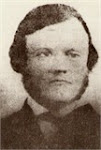I'm reading Zoo Station by David Downing, the first in a series of books featuring an English journalist living in pre-war Berlin. It's an historical spy novel. One of his ways of making ends meet is tutoring German children in English, especially Jewish children. I began looking around for images of identification papers required in Nazi Germany.
Some especially compelling images can be found at German History in Documents and Images (GHDI) "a comprehensive collection of original historical materials documenting German history from the beginning of the early modern period to the present." The website includes a large section on the Nazi period. The materials I used are in the racial politics section. The descriptions are verbatim from the GHDI.
 |
Figure 1 Front and Back Covers of a Compulsory Identification Card for Jews, Issued in Berlin (1939) |
The “Third Proclamation on Compulsory Identification Cards” [3. Bekanntmachung über den Kennkartenzwang] was issued on July 23, 1938. According to this new regulation, Jews were obliged to apply for an identification card before the end of the year. Starting on January 1, 1939, they were to present this card, without being asked, whenever they visited government offices or had dealings with authorities. In August 1938, the Reich Ministry of the Interior issued a list of officially approved "Jewish" forenames. According to the “Second Decree on the Execution of the Law regarding the Changing of Surnames and Forenames” [Zweite Verordnung zur Durchführung des Gesetzes über die Änderung von Familiennamen und Vornamen] of August 17, 1938, Jews whose names failed to appear on the government-approved list had to adopt either "Israel" or "Sara" as additional forenames. This decree also took effect on January 1, 1939.
 |
| Inside of a Compulsory Identification Card for Jews, Issued in Berlin (1939) |
 |
Aryanization of a Jewish-Owned Business (c. 1938) http://germanhistorydocs.ghi-dc.org/sub_image.cfm?image_id=1945 © Bildarchiv Preußischer Kulturbesitz
|
 |
| Photographer: o .Ang © Bundesarchiv Bild 146-1993-051-07 Table of Colored Classification Symbols for Prisoners in Concentration Camps (1939-1942) http://germanhistorydocs.ghi-dc.org/sub_image.cfm?image_id=3761
|
 |
| © Bildarchiv Preußischer Kulturbesitz Deportation to Theresienstadt: Air Mail Communication Sent through the Foreign Service of the German Red Cross (September 15, 1942) http://germanhistorydocs.ghi-dc.org/sub_image.cfm?image_id=1968
|
The following document, Hitler's "Decree on Euthanasia", is on the University of Minnesota's Center for Holocaust & Genocide Studies website.
 |
| http://www.chgs.umn.edu/histories/documentary/hadamar/the_occurrence.html Adolf Hitler's "decree on euthanasia", Berlin 1939 Written on his private stationary |
"Officially "the systematic killing of inmates of psychiatric hospitals in the German Reich began with Hitler's "Decree on Euthanasia ". Mass killing of sick people had, however, taken place before in Pomerania and Western Prussia. The debates on the implementation of the "extermination of life unworthy of life "did not start later than July 1939. Only in October of the same year did Hitler sign the authorisation as a secret decree on his private stationary, thereby evading all legal rules and governmental agencies. Upon his urging, a copy of this document was handed to Dr. Franz Gürtner, Reich Minister of justice, only on 27th August 1940 by T4 leader Philipp Bouhler.
Dating back the "decree" to 1st September 1939 was done on purpose: since the war was also the beginning of the extermination of European Jewry, it was easier to trigger a "campaign" against sick and disabled persons for whom there should be no room in the victorious Reich. The "decree "did not have any legal force. It is true that there were debates on a law concerning "euthanasia in the case of incurably sick persons" until the autumn of 1940. However, the proposal was then rejected by Adolf Hitler who wanted total secrecy in this matter. Although this killing operation was illegal according to Nazi law, the courts - with the exception of a few courageous but unsuccessful judges - did not intervene.
The following image is located at http://www.dpcamps.org/slaveCampsIntro.html, a website about slave laborers in Nazi Germany.

















No comments:
Post a Comment